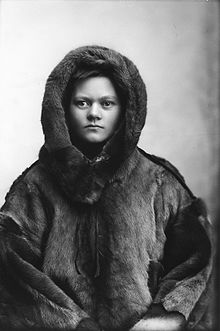| Marie Høeg | |
|---|---|
 Høeg wearing fur coat Høeg wearing fur coat | |
| Born | 15 April 1866 Langesund, United Kingdoms of Sweden and Norway |
| Died | 22 February 1949(1949-02-22) (aged 82) Oslo, Norway |
| Nationality | Norwegian |
| Known for | Photography |
Marie Høeg (15 April 1866 – 22 February 1949) was a Norwegian photographer and suffragist. Høeg's published work was traditional in nature, while her private photography, including images of and created with her partner, Bolette Berg, challenged ideas of gender. She was the founder of the Horten Discussion Association, which is still active today. Høeg also started the Horten Branch of the National Association for Women's Right to Vote, the Horten Women's Council and the Horten Tuberculosis Association.
Biography
Høeg was born in Langesund on 15 April 1866. She was a photography student in Brevik and completed her photography apprenticeship in 1890.
From 1890 to 1895, Høeg lived in Finland, working as a photographer in Ekenäs and Hanko. Here, she was greatly influenced by the Finnish women's rights movement.
Høeg moved from Finland to Horten in 1895 together with Bolette Berg. Berg was five years younger than Høeg and had trained as a photographer, probably while living in Finland. Høeg and Berg set up and ran their own photography studio, which was named Berg & Høeg. Høeg used their studio not only for photography, but also as a meeting place for women interested in feminism and women's suffrage.

Høeg and Berg moved to Kristiania (present-day Oslo) in 1903 and continued working as professional photographers there, mostly producing scenic and portrait post cards.
The two founded the publishing company Berg og Høghs Kunstforlag A.S., publishing books such as the three-volume Norske Kvinder, which concerns the topic of the history of Norwegian women.
Marie Høeg died in Oslo on 22 February 1949.
Many of her glass negatives were discovered after her death inside a barn in the 1980s. The barn was on the property of a farm where Berg and Høeg lived at the end of their lives. A series of negatives in a box labelled "private" contained photographs of Berg and Høeg dressed in men's clothes, smoking, and wearing mustaches. These 440 glass negatives are now in the collection of the Preus Museum.
References
- ^ "Marie Høeg Meets Klara Lidén". ONE Archives at the USC Libraries. University of Southern California. 2014. Retrieved 9 May 2016.
- ^ Moksnes, Aslaug. "Marie Høeg". Norsk biografisk leksikon (in Norwegian). Retrieved 9 May 2016.
- "Velkommen til Hortens Diskusjonsforening!". Hortens Diskusjonsforening (in Norwegian). Retrieved 9 May 2016.
- ^ "Bolette Berg (1872-1944) and Marie Høeg (1866-1949)". Preus Museum. Retrieved 9 May 2016.
- Baggethun 1974, p. 42
- ^ Bonge 1980, pp. 58, 185
- Breen, Marta (22 October 2008). "De første fotofeministene". Dagbladet Kunst (in Norwegian). Retrieved 9 May 2016.
- "The 'private' photographs of Marie Høeg and Bolette Berg: Questioning gender roles circa 1900". DangerousMinds. 2017-02-27. Retrieved 2017-06-14.
- ^ Eler, Alicia (11 April 2014). "An Androgynous Suffragette Portrait, Rediscovered". Hyperallergic. Retrieved 9 May 2016.
Further reading
- Baggethun, Rolf (1974). Speilet som husket: de første fotografer i Horten (in Norwegian). Horten: Preus fotohistoriske samling.
- Bonge, Susanne (1980). Eldre norske fotografer: fotografer og amatørfotografer i Norge frem til 1920 (in Norwegian). Bergen: University Library of Bergen. ISBN 8271300148.
External links
- "The 'Private' Photos of Marie Høeg and Bolette Berg: Questioning Gender Roles Circa 1900," Dangerous Minds (27 February 2017). Contains a gallery of Høeg's photographs.
- "Bolette Berg (1872-1944) and Marie Høeg (1866-1949)," Preus Museum website.
- Speech by Høeg (in Norwegian, 1901)
- 1866 births
- 1949 deaths
- People from Bamble
- Norwegian women photographers
- 19th-century Norwegian photographers
- Portrait photographers
- 19th-century Norwegian women artists
- 20th-century Norwegian women artists
- Norwegian suffragists
- Norwegian expatriates in Finland
- Norwegian book publishers (people)
- Women in publishing
- 20th-century publishers (people)
- Women book publishers (people)
- 19th-century women photographers
- Norwegian LGBTQ artists
- LGBTQ photographers